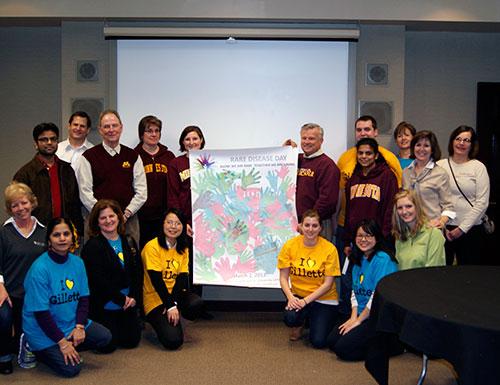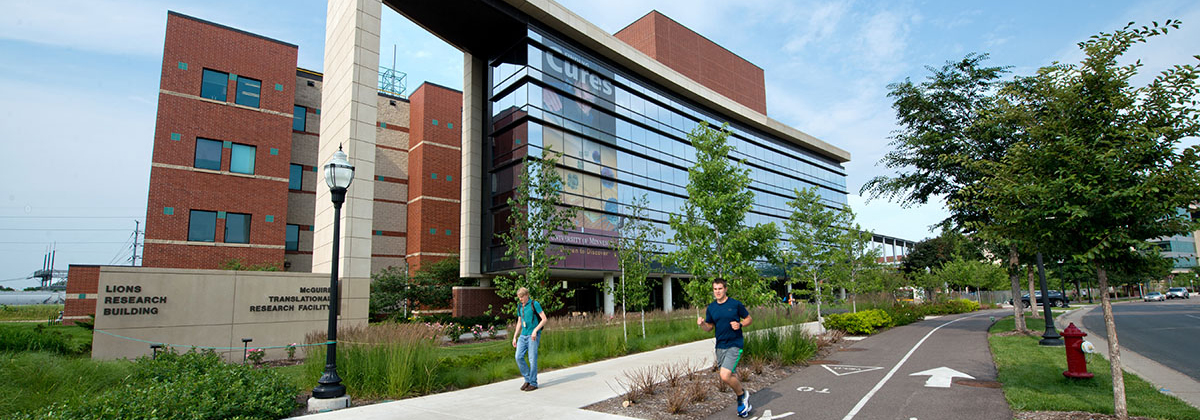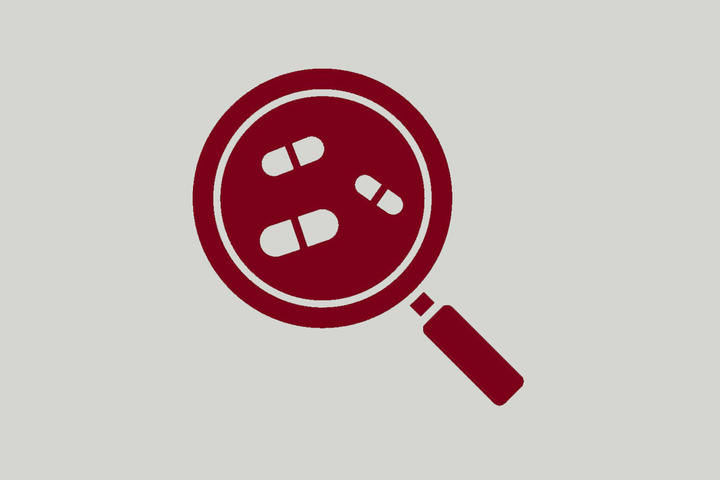Since its inception in 2005, the Center for Orphan Drug Research (CODR) has been improving the care of individuals suffering from rare diseases through research, increased education efforts, and by taking an active role in shaping public policy applicable to rare diseases and orphan drug development.
Orphan Drug Research and Development Process

We Provide Hope for People with Rare Diseases
For decades, Americans diagnosed with rare diseases had little hope. Drugs used to treat such conditions – known as “orphan drugs” – often never made it out of the lab as prioritization was put on drugs that would help conditions affecting millions. Then, in 1983, Congress passed the Orphan Drug Act in order to stimulate the development of new treatments for rare diseases. The move worked; since 1983 more than 350 new drugs have been developed.
Today, the University of Minnesota Center for Orphan Drug Research is investing new resources into the development of orphan drugs and drug delivery systems that could impact the lives of millions of people both in Minnesota and across the United States.
RARE: Stories of Dis-ease
The University's Center for Orphan Drug Research and Theatre Arts and Dance Department—in collaboration with rare disease community members—have produced a play that examines the challenges of those living with rare disorders. Over 7,000 diseases are considered rare, affecting one in ten Americans and their families who face delays in diagnosis and few available effective treatments. The show creators adapted the Greek tragedy, Philoctetes, to tell the story of the challenges faced by people diagnosed with a rare disease.
Graduate Education
CODR offers research opportunities for students accepted into the ECP Graduate program. Interested individuals should contact Dr. Cloyd, cloyd001@umn.edu to discuss their interest and the availability of projects. In addition to research training, exposure to clinical care in relevant areas is also available.
The center in collaboration with the Medical School Gene Therapy Program offers a research training program in the pharmacotherapy and metabolic disorders. For additional information please contact Jeanine Utz, PharmD, utzx0002@umn.edu.
PharmD Students
Directed Research/ Directed Study Registration
Under the direction of a faculty member, students may earn Directed Research or Directed Study credits for special projects. Occasionally special topics classes are also offered under Directed Study course numbers. University guidelines indicate the following expectations for one credit of Directed Research or Directed Study:
- 15 hours/semester of meeting time with faculty director
- 2 hours/week outside of that meeting time
- Thus 1 credit = 3 hours/week = 45 hours/semester
Generally it would be difficult for a student to take more than 1 credit of Directed Research or Directed Study per semester, given the above time requirements.
Directed Research and Directed Study may be taken on the A/F or S/N grading basis. The student and faculty director should discuss which grading basis to use before the student registers.
Students may count Directed Research and Directed Study credits toward the required 10 credits of electives (even if taken on the S/N grading basis).
To register for Directed Research and Directed Study, students need faculty permission. After discussion with a faculty member who agrees to direct the research or study, the faculty member should email his or her permission to OSS: Amy Renne (Duluth campus) at arenne@d.umn.edu or Peter Haeg (Twin Cities campus) at haegx002@umn.edu, who will register the student for the Directed Research or Study. The email should also specify the number of credits and the grading basis.
- PHAR 6293 Directed Research I
(prereq instr consent ) 1-5 credits - PHAR 6294 Directed Study I
(max 5 credits; 5 repeats allowed; prereq instr consent) 1-5 credits - PHAR 6393 Directed Research II
(prereq instr consent ) 1-5 credits - PHAR 6394 Directed Study II
(max 5 credits; 5 repeats allowed; prereq instr consent ) 1-5 credits - PHAR 6493 Directed Research III
(max 5 credits; 5 repeats allowed; prereq instr consent) 1-5 credits
Fourth year students in the PharmD program may request an academic rotation with CODR. This experience can be tailored to the students' interests while still providing an overview of a career in academia.
A New Course Added
A new College of Pharmacy directed study course based on attendance at the weekly CODR research conferences was approved spring semester 2014. The course (ECP 8900 - Advanced Topics in Experimental and Clinical Pharmacology) is a highly interactive discussion on topics related to rare disorders and research, economics, regulatory and public policy aspects of orphan drugs. The primary instructor is Reena Kartha. M.S., PhD
Undergraduate Students
CODR has some opportunities for undergrad students to gain research experience. Scholarships are available through the Undergraduate Research Opportunities Program (UROP).
New Course Added
A new Grand Challenge Curriculum freshman seminar course is added and will be offered in Fall 2020.
"Rare Diseases: What it Takes to Be a Medical Orphan" (GCC 1906) is a highly interactive discussion on topics related to rare disorders and research, economic, regulatory and public policy aspects of orphan drugs. The primary instructor is Reena Kartha, MS, PhD.
Research Experience Projects – Year Plus Research Experience for Students
CODR has opportunities for PharmD students to gain translational and/or clinical research experience by working on a project. The length of commitment will vary by project depending upon the project and the student's goals. The experience can either take the form of directed research or a paid research opportunity. Students interested in applying for a Melendy Research Scholarship will be given preference.
Seizure Disorders
ESETT: Established Status Epilepticus Treatment Trial (Pharmacology Core)
Project Synopsis
ESETT is multicenter, randomized, blinded, comparative effectiveness study of fosphenytoin (FOS), valproic acid (VPA) or levetiracetam (LVT) in the emergency department treatment of patients with benzodiazepine (BDZ) refractory status epilepticus (SE). The main objective is to determine the most effective and/or least effective treatment of BDZ refractory SE among patients older than 2 years. The primary outcome is clinical cessation of status epilepticus, without recurrent seizures, life-threatening hypotension or cardiac arrhythmia, or use of additional anti-seizure medications within 60 minutes of the start of study drug infusion. The drug dosing regime in ESETT is weight-based, patients weighing < 75Kg receive FOS 20 mg/Kg, or VPA 40 mg/Kg, or LVT 60 mg/Kg, but those weighing more than 75 Kg receive fixed doses of 1500 mg FOS, 3000 mg VPA and 4500 mg LVT. As an ancillary study, we are proposing the evaluation of drug exposure and response relationships.
PIs: Jaideep Kapur, MD; Robert Silbergleit, MD; James Chamberlain, MD; Jordan Elm, PhD; James Cloyd, PharmD
Co-investigators (ESETT): Lisa Coles, PhD
Co-investigators (PK-PD only): Richard Brundage, PhD; Vijay Ivaturi, PhD; Abhishek Sathe, MS.
Funding: NIH NINDS
PK-PD of IV Allopregnalone in Dogs with Epilepsy
Project Synopsis
This project involves the use of dogs with epilepsy to characterize the pharmacokinetic and pharmacodynamic properties of approved and investigational antiseizure drugs (ASDs). The canine epilepsy model permits studies on the differential effects of ASDs on behavior, sleep, and EEG as well as the relationship between drug exposure (e.g. plasma drug concentrations) and effects such as changes in sleep or EEG patterns. Allopregnanolone is a naturally-occurring neurosteroid that is a positive allosteric modulator of synaptic and extrasynaptic GABAA receptors. A Phase III clinical trial is evaluating allopregnanolone administered by continuous intravenous (IV) infusion as a treatment for super-refractory status epilepticus (SE) in patients under general anesthesia in an intensive care setting. We hypothesize that allopregnanolone possesses the requisite pharmacokinetic (PK) and pharmacodynamic properties to support its use as an initial IV or intramuscular (IM) bolus treatment for SE. Our study objectives are to assess the tolerability and develop a PK model of allopregnanolone following a 5 minute IV infusion and an IM injection, both clinically applicable regimens for the initial treatment of SE.
PIs: Greg Worrell, MD, PhD; James Cloyd, PharmD; Ned Patterson, DVM, PhD; Lisa Coles, PhD; Ilo Leppik, MD; Michael Rogawski, MD, PhD
Funding: NIH NINDS
Development of Water-Soluble Benzodiazepine/Converting Enzyme for Intranasal Delivery Systems for Treatment of Seizure Emergencies
Project Synopsis
The goal of this project is to develop a highly water-soluble benzodiazepine prodrug intended for nasal administration that undergoes rapid metabolism in nasal epithelium or blood to an active drug. Such a compound would permit formulation of a highly concentrated drug solution capable of delivering clinically-relevant doses in small volumes (i.e. < 200 microliters) and which would cause minimal local tissue irritation and injury. Target mechanisms for biotransformation are those mediated by enzymes known to be present in nasal tissue. Compounds will be evaluated for rate of biotransformation and permeation using in vitro cell cultures. Those showing the most promise will be studied in rats and then, in dogs with epilepsy that have implanted intracranial EEGs.
PI: Ron Siegel, ScD
Co-Investigators: Jim Cloyd, PharmD; Gunda Georg, PhD; Ilo Leppik, MD; Ned Patterson, DVM, PhD; Lisa Coles, PhD
Funding: MN REACH
Epilepsy Bioinformatics Study for Antiepileptogenic Therapy (EpiBioS4Rx)
Project Synopsis
Epileptogenesis is common after traumatic brain injury (TBI)2 and begins early, offering a window of opportunity to test the efficacy of potential antiepileptogenic therapies. In order to design economically feasible clinical trials of such therapies it will be necessary to identify reliable biomarkers that: 1) predict later Post traumatic Epilepsy (PTE), to enrich the subject population; 2) stage the epileptogenic process, to determine the timing of intervention; and 3) diagnose epilepsy, to provide surrogate markers of outcome. To date promising electrical, imaging, and other biomarkers of epileptogenesis after TBI in animal models, including patholgical high frequency oscillations (pHFO) and repetitive pathological high frequency oscillations (RpFHOs) have been identified. The primary aim of the study is to perform prospective multicenter combined scalp and depth cEEG monitoring in moderate-severe TBI patients to determine if the occurrence of specific EEG changes, such as seizures, pHFOs and RpHFOs, predict later PTE. Our aims are to evaluate using pharmacokinetic and pharmacodynamic modeling and simulation to evaluate potential therapeutic agents to treat PTE.
coPIs: Engel, Galanopoulou, Moshe, Solomon, Pitkanen, and Toga
UMN Investigators: James Cloyd, Pharm.D.; Lisa Coles, Ph.D.
Funding: NIH/NINDS
MicroRNAs as Novel Biomarkers in Prolonged Seizures: Potential for Early Identification of Epilepsy
Project Synopsis
In this study, we will use a “two-hit” mouse model of epileptogenesis to understand the effect of seizures on miRNA expression in different brain regions. Seizures in immature animals cause subtle functional changes without causing cell death; however, this first hit (early seizure) can drastically alter the response to repeated seizures (second hit) later in life. This mimics the clinical characteristics of children with prolonged seizures. Thus a “two-hit” approach is a clinically relevant model of epilepsy and examining microRNA expression in brain and blood can provide information on the utility of microRNAs as diagnostic and prognostic biomarker of epilepsy.
PI: Reena Kartha, PhD
Co-Investigators: James Cloyd, PharmD; Sookyong Koh, MD (Emory University)
Funding: College of Pharmacy Grants Award Program (GAP)
Circulating MicroRNAs as Potential Biomarkers for Epilepsy
Project Synopsis
The long term goal is to evaluate the potential use of circulating microRNAs as clinical biomarkers in epilepsies. In this project, we will examine the temporal variation in blood microRNA expression following seizures in canines with naturally occurring epilepsy. Towards this end we will collect blood samples from these dogs prior to and immediately after a seizure episode at different time points. Circulating microRNAs will be analyzed using small RNA sequencing approach to understand changes in expression following a seizure.
PIs: Reena Kartha, PhD; Edward E Patterson, DVM, PhD
Co-investigators: Bridget Curtin; James Cloyd, PharmD; Anne Sarver, PhD; Subbaya Subramanian, PhD
Funding: American Kennel Foundation
MicroRNAs as Clinical Biomarkers to Understand Phenotypic Heterogeneity in Tuberous Sclerosis Complex
Project Synopsis
Tuberous Sclerosis Complex (TSC) is a multisystem genetic disorder due to mutations in either TSC1 or TSC2 gene resulting in variable phenotypic expression. Epilepsy is the most common presenting symptom in TSC with approximately one-third of patients developing intractable epilepsy.The objective of this project is to determine circulating microRNA expression signatures in patients with TSC. We hypothesize that in comparison to healthy individuals, blood samples from patients with TSC have a unique miRNA expression signature. The dysregulated miRNAs can potentially cause differential gene expression contributing to the varied phenotypic spectrum in adults with TSC, including intractable epilepsy.
PI: Reena Kartha, PhD
Co-investigators: Mike Frost, MD; James White, MD; Nithin Agarwal, MD (Minnesota Epilepsy Group)
Funding: TBD
Spasticity
Development of IV Baclofen for Prevention and Management of Baclofen Withdrawal Syndrome
Project Synopsis
This project is directed at developing a new therapy to treat the symptoms associated with acute withdrawal of baclofen, a drug used to treat spasticity. The acute withdrawal syndrome can occur when spinal cord infusion of baclofen by pump is interrupted due to pump dysfunction, catheter dislocation, or site infection or when oral baclofen is interrupted because of a patient’s inability to take medications by mouth. Fewer than 5,000 patients per year experience baclofen withdrawal syndrome. In addition, there are circumstances when interruption of oral baclofen therapy is anticipated (such as elective major surgery), and substitution with intravenous medication would reduce the risk of developing withdrawal.
Co-PIs: Robert Kriel, MD; Co-PI: Linda Krach, MD
Co-Investigators: James Cloyd, PharmD; Lisa Coles, PhD;
Funding: Allaysis, Inc
Project Coordinator: Natalie Schmitz, PharmD
Neurodegenerative Disorders
Lorenzo's oil in the Treatment of Adrenoleukodystrophy
Project Synopsis
X-linked adrenoleukodystrophy (ALD) is a genetic disorder leading to accumulation of saturated very long chain fatty acids (VLCFAs; mainly C26:0) in tissues. This accumulation causes demyelination of neurons in the brain and adrenal dysfunction. Childhood cerebral ALD (CCALD) is the most severe and devastating form of this disease and affects school-age boys, leading to death in 2-3 years. Lorenzo’s oil (LO) is believed to competitively inhibit the elongation of long chain fatty acids to VLCFAs and clinical studies have shown a reduction in plasma VLCFAs in patients receiving LO. Additionally, literature suggests LO may reduce the development of cerebral involvement in ALD children, but studies on outcomes are conflicting. This is partially due to variability in dosing across studies and a complete lack of information on the pharmacokinetics and pharmacodynamics that characterize the dose-response relationship. The primary objective of this project is to determine the pharmacokinetics of erucic acid (a component of LO) in patients with X-linked ALD. This information will help optimize LO dosing in order to obtain desirable outcomes.
PIs: Mariam Ahmed, PhD; Gerald Raymond MD
Co-investigators: Reena Kartha, PhD; Richard Brundage, PharmD, PhD; Bradley Carlin, PhD; James Cloyd, PharmD;
Funding: CTSI Translational Research Development Program
Improved Therapy for Late-stage Adrenoleukodystrophy
Project Synopsis
Childhood cerebral adrenoleukodystrophy (c-ALD) is an X-linked peroxisomal disorder affecting approximately 20,000 boys that results in demyelination of the CNS and early death in affected boys. Hematopoietic stem cell transplantation (HSCT) halts disease progression and extends life when c-ALD is diagnosed and treated at an early stage. There is, however, no known effective therapy for late-stage c-ALD although HSCT is offered at some centers. Survival and neurological outcomes are significantly worse in late-stage as compared to early-stage disease. N-acetylcysteine (NAC) is an antioxidant that reduces free radicals and facilitates glutathione biosynthesis. Our research team administered NAC to reduce oxidative damage and potentially render late-stage disease amenable to HSCT. The results indicate that IV NAC therapy, in conjunction with a reduced intensity transplant, significantly improves survival of boys with late stage-disease as compared to HSCT alone. Our studies are focusing on NAC clinical pharmacology and include both clinical and cell-based in vitro research . The goal of our research is to develop safer, more effective therapies for c-ALD including use of NAC as preventive therapy in children with early-stage disease.
PIs: James Cloyd, PharmD, Paul Orchard, MD
Co-investigators: Jakub Tolar, MD, PhD; Richard Brundage, PharmD, PhD; Reena Kartha, Gerald Raymond, MD; Troy Lund, MD, PhD; Lisa Coles, PhD; Jie Zhou, PhD; Mary Holmay, PhD
Past Funding: UMN Academic Health Center Faculty Development Grant
Validation of Testing for Emerging Cerebral Adrenoleukodystrophy to Enable Clinical Trial Readiness– Oxidative Stress
Project Synopsis
The primary objective of this project is to gain critical information regarding the early evolution of cerebral disease in adrenoleukodystrophy (ALD). Childhood cerebral ALD (ccALD) is a progressive, debilitating and ultimately lethal form of ALD. The University of Minnesota treats more patients with ccALD than any in the world, and it is clear that we need to improve outcomes for these patients. We have not previously had the opportunity to gather prospective data in a sufficiently large cohort of boys with ALD prior to the onset of cerebral disease to study the evolution of ccALD. However, with the emergence of newborn screening for ALD this will now prove feasible.
PIs: Gerald Raymond, MD; Paul Orchard, MD
Co-investigators: Troy Lund, MD, PhD; Weston Miller,MD; David Nascene, MD; Igor Nestrasil, MD; James Cloyd, PharmD, Reena Kartha, PhD; Julie Eisengart, PhD, LP; Bradley Carlin, PhD
Funding: TBD
Oxidative Stress-related Biomarkers in Gaucher Disease: a Preliminary Study
Project Synopsis
The primary objective of this study is to evaluate oxidative stress in patients with Gaucher disease using a series of biomarkers and correlate with clinical diagnostic biomarkers. Additionally, the relationships between oxidative stress and variables including therapy or intervention (for example ERT, SRT) and disease severity will be evaluated. We hypothesize that compared to healthy individuals subjects with GDI will have increased oxidative stress which can be normalized by intervention.
PI: Reena Kartha, PhD
Co-investigators: James Cloyd, PharmD; Jeanine Utz, PharmD; Chester Whitley, PhD, MD; Kyle Rudser, PhD
Funding: Genzyme
Role of Oxidative Stress and Inflammation in Type 1 Gaucher Disease (GD1): Potential Use of Antioxidant/Anti-inflammatory Medications
Project Synopsis
The primary objective of this study is to characterize oxidative stress and inflammation in the blood and brain of individuals with GD1 and determine whether these factors can be altered with orally administered N-acetylcysteine (NAC). Additionally, correlations between peripheral (plasma or red blood cell) concentrations of NAC, cysteine, and glutathione with central (brain) glutathione levels will be evaluated in subjects with GD1.NAC and glutathione pharmacokinetics will also be characterized in this population with the intent to construct models linking pharmacokinetics with biomarker changes.
PIs: James Cloyd, PharmD; Reena Kartha, PhD;Jeanine Utz, PharmD
Co-investigators: James Cloyd, PharmD;; Chester Whitley, PhD, MD; Kyle Rudser, PhD
Funding: Lysosomal Disease Network, Pfizer
Lysosomal Disease Network
Project Synopsis
The Lysosomal Disease Network (U54NS065768) is a part of the Rare Diseases Clinical Research Network (RDCRN), an initiative of the Office of Rare Diseases Research (ORDR), and NCATS. This network focuses on observational and intervention studies of various lysosomal diseases.
PIs: Chester Whitley, PhD, MD; James Cloyd, PharmD
Co-investigators(Pharmacotherapy Core): Reena Kartha, PhD; Lisa Coles, PhD
Funding: Through a collaboration between NCATS, NINDS, and NIDDK
Effects of Yoga on Oxidative Stress, Motor Function and Psychosocial Well-being in Individuals with Parkinson’s Disease
Project Synopsis
Parkinson’s disease (PD) is a progressive neurodegenerative condition, in which motor and nonmotor features are currently not being sufficiently managed. Although the pathology of PD is complex, oxidative stress is recognized as a potential factor in the pathogenesis of PD. Hatha yoga has been shown to reduce oxidative stress in people with chronic health problems such as hypertension and diabetes; and improve gait, physical function, and quality of life in people with neurological disorders such as stroke and multiple sclerosis, however, studies carried out on the effects of yoga in PD are sparse. It is crucial to assess whether yoga is able to improve symptoms and alter the underlying biology of PD. The purpose of this study is to assess the effect of yoga on measures of oxidative stress, motor function, and psychosocial well-being as well as the feasibility and acceptability of implementing a yoga program in PD subjects.
PI: Corjena K. Cheung, PhD, RN
Co-Investigators: Jean Wyman, PhD; Jürgen Konczak, PhD; Paul Tuite,MD; Reena Kartha, PhD; Catherine Justice, DPT
Funding: Grant-in-Aid of Research, Artistry and Scholarship Program, Midwest Nursing Research Society (MNRS)
Oral UDCA in Parkinson’s disease
Project Synopsis
We are interested in understanding the bioenergetic impairments that underlie Parkinson’s disease (PD) and evaluating treatments that may improve abnormal mitochondrial function that is present in PD. High field - 7 tesla (T) - magnetic resonance spectroscopy (MRS) is able to non-invasively assess for changes in brain energetics and will be used to evaluate the effects that repeated oral doses of the mitochondrial enhancer ursodeoxycholic acid (UDCA) has on brain bioenergetics derived from MRS measurements. The primary aim of the study is to measure plasma UDCA levels in individuals with PD at baseline and after four weeks of repeated high doses of oral UDCA (50mg/kg/day) and combine results obtained using MRS brain scans along with peripheral measurements of bile acids (e.g., total UDCA). Secondary aim of the study is to characterize oral UDCA pharmacokinetics and develop a pharmacokinetic/pharmacodynamic model to characterize the relationship between peripheral measurements of UDCA (and associated conjugates) and peripheral measures and/or central (brain) bioenergetic measurements.
PIs: Wei Chen, Ph.D.; James Cloyd, Pharm.D.
Co-Investigators: Lisa Coles, Ph.D; Paul Tuite, M.D.; Xiao-Hong Zhu
Funding: University of Minnesota, Academic Health Center
Intranasal naloxone for treatment of impaired awareness of hypoglycemia
Project Synopsis
Recurrent exposure to iatrogenic hypoglycemia in patients with insulin treated diabetes can lead to development of impaired awareness of hypoglycemia (IAH). Naloxone- an opiod receptor antagonist has been shown to modulate hormonal response during hypoglyceamia and may play a role in the treatment of impaired awareness of hypoglycemia (IAH).This is a single center, single blind randomized cross-over design trial to evaluate intranasal nalaxone therapy for prevention and treatment of IAH. Secondary objective of this project is to characterize naloxone pharmacokinetics following multiple administrations. A 4mg dose of Narcan (naloxone hydrochloride) intranasal spray will be administered every 8 hours in one day. The primary endpoint of the study will be the within person difference in epinephrine secretion during the morning episodes of hypoglycemia on days one and two under the two treatment conditions.
Investigators: Amir Moheet, M.D.; Elizabeth Seaquist, M.D.; Lisa Coles, PhD.; Lynn Elberly, Ph.D.
Funding: University Of Minnesota, Academic Health Center
Other Projects
Post-PharmD Fellowship in Pharmacotherapy of Inherited Metabolic Diseases
Project Synopsis
Enzyme replacement therapy for rare inherited metabolic diseases such a Pompe, Hurler’s, and Gaucher are life-extending, but expensive. Individualized titration and careful management of these biologics can ensure optimal outcomes while minimizing costs. The investigators have designed a residency for pharmacists that will provide them with the training needed to provide exceptional clinical care of patients requiring enzyme replacement therapy as well as the opportunity to develop research skills related to the pharmacotherapy of rare disorders.
Co-PIs: Jeanine Utz, PharmD; James Cloyd, PharmD
Co-investigator: Chet Whitley, MD, PhD
Funding: GenzymeOral N-acetylcysteine for treatment of hypoglycemia associated autonomic failure
Project Synopsis
The purpose of this project is to evaluate N-acetyl cysteine (NAC) as a therapy for the prevention and treatment of hypoglycemia associated autonomic failure (HAAF) in patients with type 1 diabetes. Impaired awareness of hypoglycemia occurs in approximately 25% of adults with type 1 diabetes and is associated with a six fold higher risk of having severe hypoglycemia that requires the assistance of another to recognize and treat. HAAF is also the primary barrier to achieving the level of glucose control necessary to prevent the microvascular complications of the disease and contributes to the mortality seen in patients with T1DM. This is a single center, double blind randomized cross-over design trial that will compare the impact of N-acetylcysteine (150 mg) vs. saline infusion during experimental hypoglycemia on day one on the responses to experimental hypoglycemia on day two. Primary endpoint will be the within person difference in epinephrine secretion during the morning episodes of hypoglycemia on days one and two under the two treatment conditions. As a secondary endpoint the exposure-response relationships will be explored.
PI: Elizabeth Seaquist, M.D.
Co-Investigators: Amir Moheet, M.D.; Lisa Coles, Ph.D.; Lynn Elberly
Funding: JDRF
News
Contact Us
Center for Orphan Drug Research
4-208 McGuire Translational Research Facility
2001 - 6th St SE, Minneapolis, MN 55455
Phone: 612-626-6112
Fax: 612-301-1574
codr@umn.edu





